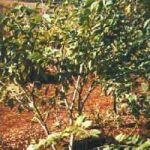| Common Name: |
Jaborandi |
| Other Names: |
Maranham Jaborandi |
| Botanical Name: |
Pilocarpus microphyllus |
| Genus: |
Pilocarpus |
| Family: |
Rutaceae |
| Native Location: |
Brazil. |
| Cultivation: |
Rich, well-drained soil in partial shade and high humidity. |
| Propagation: |
By seed sown when ripe; by ripewood cuttings with leaves intact during the growing season. |
| Harvest: |
Leaves and leafy twigs are picked as required, and dried for extraction of alkaloids and for use in liquid extracts and tinctures. |
| Height: |
1.2-1.5m (4-5ft) |
| Width: |
1m (3ft) |
| Hardiness: |
Min. 15-18°C (59-64°F) |
| Parts Used: |
Leaves, Leafy Twigs |
| Properties: |
A bitter, slightly aromatic herb that stimulates the heart, causes copious perspiration and salivation, contracts the pupils, and reputedly increases hair growth. |
| Medicinal Uses: |
Internally for psoriasis, itching of the skin, syphilis, chronic mucus, and dropsy (leaf extracts). Internally and externally for glaucoma and as an antidote to atropine (pilocarpine); externally for hair loss (leaf extracts). |
| Warning: |
Excess causes profuse perspiration and salivation, rapid pulse, contracted pupils, diarrhea and vomiting, and may be fatal.
This herb, especially in the form of pilocarpine and leaf extracts, is subject to legal restrictions in some countries. Use of jaborandi in cosmetics is prohibited in many countries. |
| Bibliography: |
Encyclopedia of Herbs by Deni Brown Copyright © 1995, 2001 Dorling Kindersley Limited Pg 316 |

